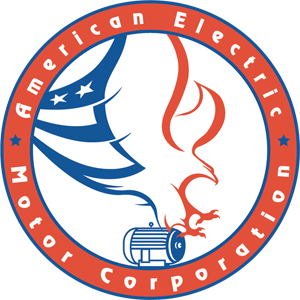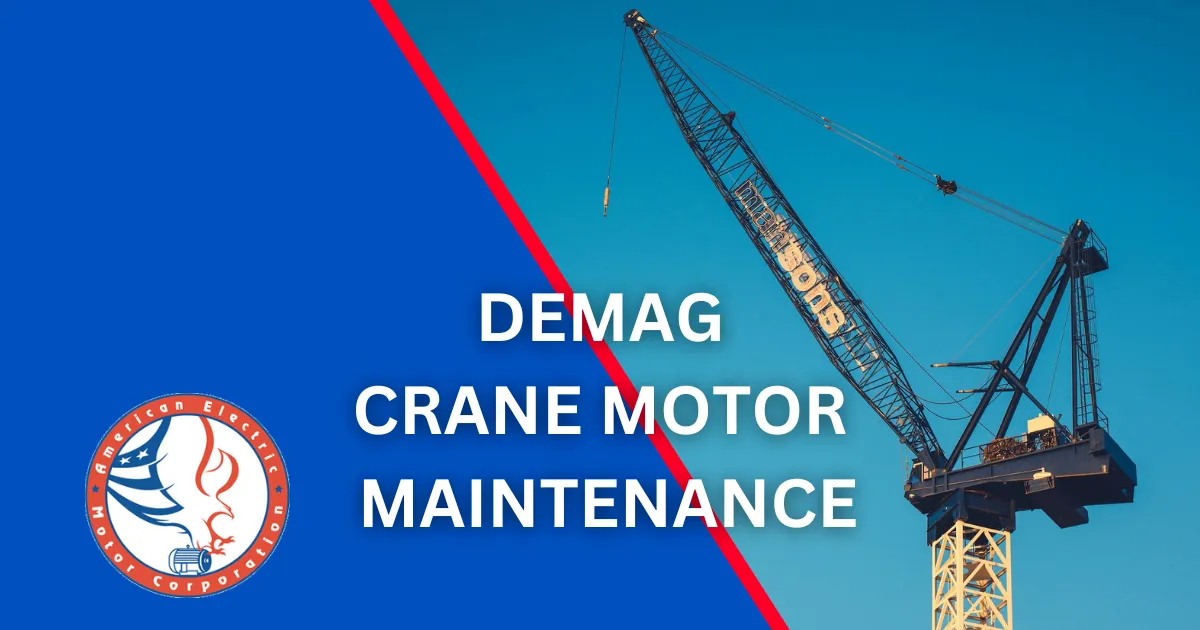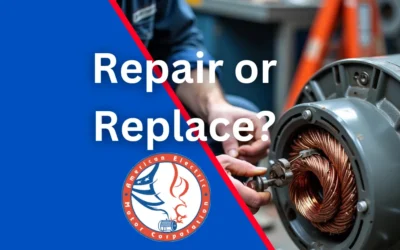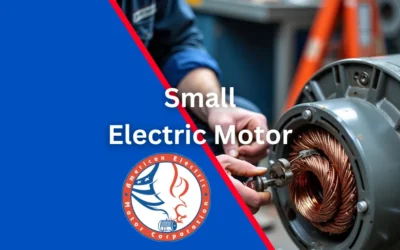In the world of overhead crane motors in industrial operations, few pieces of equipment command as much respect—and carry as much responsibility—as an overhead crane. It is the workhorse of the facility, lifting and moving critical loads with a precision that dictates the pace of production. But the heart of this powerful machine is its electric motor, and when that heart begins to fail, it’s not just an inconvenience—it’s a ticking clock on a critical safety and operational crisis.
A crane motor failure can lead to catastrophic outcomes: dropped loads, life-altering injuries, and crippling downtime that can shut down an entire facility. The problem is that these failures rarely happen without warning. They are preceded by a series of subtle clues and telltale signs that, if caught early, can turn a potential disaster into a scheduled, controlled repair.
For over 30 years, American Electric Motors has been an authorized DEMAG repair center, specializing in the complex systems that power industrial cranes. We understand that motor reliability is non-negotiable. This guide is your first line of defense. We will teach you how to spot the five most common warning signs that your overhead crane motor is headed for failure, empowering you to take proactive measures to protect your team, your equipment, and your bottom line.
Sign 1: Unusual Noises – The Language of Mechanical Distress
An experienced operator knows the normal sounds of their crane—the smooth, consistent hum of the motor, the gentle click of the contactors. The most immediate sign of a developing problem is a change in this familiar soundtrack. These new noises are not random; they are specific indicators of mechanical distress.
- Grinding or Rumbling: This is the most alarming sound a motor can make and almost always points to advanced bearing failure. The bearings are what allow the motor’s shaft to rotate smoothly with minimal friction. When they lose lubrication or become contaminated, the internal components begin to wear down. A grinding noise is the sound of metal-on-metal destruction as the bearings disintegrate. If you hear this, the motor is on borrowed time and a complete seizure is imminent.
- High-Pitched Whining or Squealing: While less aggressive than grinding, a persistent whining sound is a serious warning. It can indicate several issues:
- Early-Stage Bearing Failure: Before they begin to grind, failing bearings will often emit a high-pitched squeal as friction increases.
- Brake Drag: The crane’s brake may not be fully disengaging when power is applied to the motor. This forces the motor to work harder against the brake’s friction, producing a whining sound and generating excessive heat.
- Gearbox Issues: The noise may also originate from the connected gearbox, indicating worn gears or improper lubrication that is putting extra strain on the motor.
Ignoring these sounds is the equivalent of ignoring a fire alarm. They are direct communications that a critical component is failing. A technician needs to investigate the source immediately to prevent a minor issue from escalating into a full-blown motor replacement.
Sign 2: Overheating and Excessive Vibration
Heat and vibration are the twin enemies of an electric motor. While all motors produce some heat and vibration during normal operation, an increase in either is a clear signal that the motor is operating inefficiently and under stress.
- Overheating: If a motor is too hot to comfortably touch for more than a few seconds, it’s running too hot. This excess heat is a symptom of a deeper problem and actively degrades the motor’s most critical components. The insulation around the copper windings in the armature is particularly vulnerable. As it breaks down from heat exposure, it can lead to a short circuit and a complete motor burnout. Common causes include:
- Electrical Overload: The crane is consistently lifting loads beyond the motor’s rated capacity.
- Poor Cooling: The motor’s cooling fins are clogged with dirt and debris, preventing proper heat dissipation.
- Internal Friction: Failing bearings or misalignment are creating excess friction and, consequently, heat.
- Winding Failure: The insulation within the motor is beginning to fail, causing increased electrical resistance.
While the “touch test” is a crude indicator, a professional diagnosis using thermal imaging is far more effective. An infrared camera can pinpoint the exact source of the heat, allowing for a precise and rapid diagnosis.
- Excessive Vibration: A well-maintained crane motor should run smoothly. If you begin to notice new or increasing vibrations in the crane structure or the motor itself, it’s a sign of a developing mechanical issue. Vibration can be caused by a misaligned shaft, an imbalanced load, or worn gears. Left unchecked, this vibration will not only accelerate the wear on the motor’s bearings and windings but can also cause structural fatigue in the crane’s framework and mounting bolts, creating a widespread safety hazard that falls short of OSHA’s stringent safety standards.
Sign 3: Inconsistent Speed or Loss of Power
A crane’s ability to lift and move loads with precise, predictable control is paramount. When the motor begins to lose power or its speed becomes erratic, this control is compromised, creating a dangerous operating condition.Look for symptoms like:
- The crane hesitates or struggles when lifting a load it could previously handle with ease.
- The speed of the hoist or trolley is inconsistent, sometimes moving faster or slower than commanded.
- The motor seems to “lag” or fails to respond immediately to operator controls.
These issues often point to an electrical problem within the motor or its control system. In DC motors, worn carbon brushes can lead to poor electrical contact and reduced torque. In modern AC motors controlled by a Variable Frequency Drive (VFD), failing electronic components within the drive can send erratic signals to the motor. This could also be a sign of internal winding damage, which reduces the motor’s ability to generate a stable magnetic field and produce consistent power. Operating a crane in this condition is a serious risk, as precise load placement becomes impossible.
Sign 4: Visible Wear and Tear on Brakes and Components
The motor and its braking system are inextricably linked. A thorough visual inspection can often reveal external signs of internal problems.
Pay close attention to the braking system. The brake is what holds the load safely in the air when the motor is not actively lifting. A failing brake is a recipe for a dropped load—the single most feared accident in crane operations.
Look for:
- Excessive Brake Dust: A fine coating of black or metallic dust around the brake assembly indicates accelerated wear of the brake pads or linings.
- Scoring or Grooves: Inspect the brake drum or disc. If you can see or feel grooves worn into the metal, the brake is not applying evenly and may be damaged.
- Delayed Engagement: If you notice a “clunk” or a slight slip of the load when the motor stops, the brake is not engaging immediately and requires urgent service.
Beyond the brake, conduct a visual sweep of the entire motor assembly. Check for cracked motor housing, loose or missing mounting bolts, and frayed or damaged wiring. These may seem like minor issues, but they are often symptoms of underlying problems like excessive vibration or mechanical stress.
Sign 5: Frequent Tripping of Circuit Breakers
A circuit breaker or fuse is a safety device designed to do one thing: protect the motor from a dangerous overcurrent situation. If the breaker for your crane motor trips, it’s a clear sign that something is wrong. If it trips repeatedly, it’s a critical warning that must not be ignored.
Simply resetting the breaker without investigating the root cause is not only ineffective but also extremely dangerous. A frequently tripping breaker is indicating a serious electrical fault, such as:
- A Short Circuit: The insulation on the motor windings has failed, causing the copper wires to touch each other or the motor case, creating a direct path to ground.
- A Locked Rotor: The motor’s shaft is unable to turn due to a seized bearing or a mechanical obstruction, causing it to draw an immense amount of current.
- Severe Overloading: The motor is trying to pull far more current than it was designed for, either from a load that is too heavy or severe mechanical friction.
Continuing to reset the breaker will eventually lead to a catastrophic failure, including the potential for an electrical fire.
Don’t Wait for Failure – Trust the Certified Experts
These five signs are your early warning system. Recognizing them and taking decisive action is the hallmark of a proactive and safety-conscious operation. A failing crane motor is not a problem that will fix itself; it will only get worse, more dangerous, and more expensive to repair.
As a DEMAG Certified Motor Repair Center, American Electric Motors offers an unparalleled level of expertise. Our certification means our technicians are factory-trained to diagnose and repair these complex systems to the highest standards, using genuine OEM parts and state-of-the-art testing procedures.
Don’t wait for a catastrophic failure. Your safety and productivity are too important.
Contact our DEMAG-certified technicians today for a professional inspection and ensure your cranes are operating safely and efficiently.




